5.3.1: The Value of Biodiversity
- Page ID
- 37319
Learning Objectives
- Define biodiversity.
- Distinguish among ecosystem, species, and genetic diversity, explaining the value of each.
- Define and provide examples of ecosystem services.
- Distinguish between species richness and species evenness.
- Explain the importance of biodiversity hotspots and identify the characteristics of endemic species.
Biodiversity is a broad term for the variety of life on Earth. Traditionally, ecologists have measured biodiversity by taking into account both the number of species and the number of individuals of each species. However, biologists now measure biodiversity at a number of organizational levels, including ecosystem, species, and genetic diversity. This focuses efforts to preserve the biologically and technologically important elements of biodiversity. Biodiversity is important to the survival and welfare of human populations because it has impacts on our health and our ability to feed ourselves through agriculture and harvesting populations of wild animals.
Ecosystem Diversity
Measuring biodiversity on a large scale involves measuring ecosystem diversity, the number of different ecosystems on Earth or in a geographical area as well as their relative abundances (Figure \(\PageIndex{1}\)). The loss of an ecosystem means the loss of the interactions between species and the loss of biological productivity that an ecosystem is able to create. An example of a largely extinct ecosystem in North America is the prairie ecosystem (Figure \(\PageIndex{1}\)). Prairies once spanned central North America from the boreal forest in northern Canada down into Mexico. They are now all but gone, replaced by crop fields, pasture lands, and suburban sprawl. Many of the species survive, but the hugely productive ecosystem that was responsible for creating our most productive agricultural soils is now gone. As a consequence, their soils are now being depleted unless they are maintained artificially at great expense.
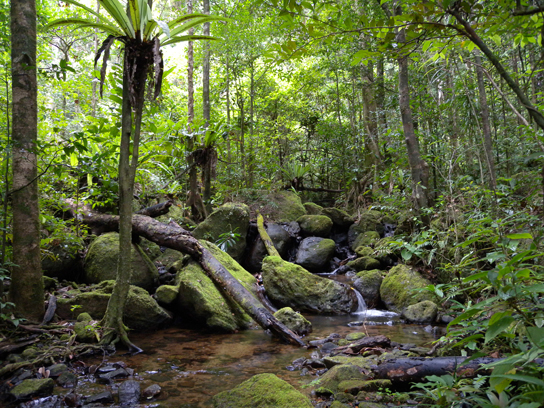
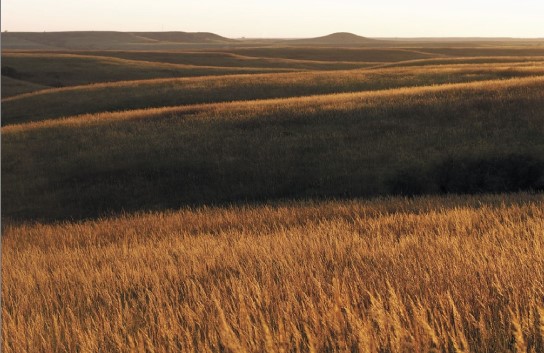
The soil productivity described above is an example of an ecosystem service. These are the products and processes associated with biological systems are directly or indirectly of immense value to the well-being of people. Some ecosystem services are processes such as the regulation of climate, flooding, and disease. Nutrient cycling, pollination, and regulation of crop pests are ecosystem services important to food production. A 2002 study by Claire Kremen and colleagues found that native pollinators in Central California (those that historically occurred there; Figure \(\PageIndex{2}\)) provided full pollination to watermelon crops (Figure \(\PageIndex{3}\)). This was only true on organic farms that were located near the natural habitat for these pollinators, highlighting the importance of sustainable farming practices and habitat conservation in preserving ecosystem services. The water cycle provides fresh water, and photosynthesis adds oxygen to our air. Other ecosystem services are human provisions including food, fuel, and fiber (such as cotton for clothing or timber). Medicines are another important provision (see Species Diversity). Furthermore, healthy ecosystems allow for recreational activities, such as hiking, kayaking, and camping, and educational opportunities, such as field trips. Nature is also the basis for a significant part of aesthetic and spiritual values held by many cultures.
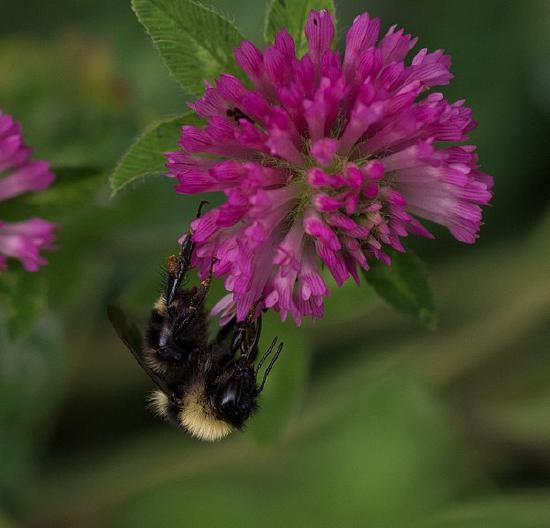

In 1997, Robert Costanza and his colleagues estimated to annual value of ecosystem services to be $33 trillion dollars ($53 trillion in 2019 dollars), and many consider this to be an underestimation. For comparison the gross domestic product of the United States in 2020 was $21 trillion.
Species Diversity
Species diversity includes species richness and species evenness. Species richness, the number of species living in a habitat or other unit, is one component of biodiversity. Species richness varies across the globe. Species evenness is a component of species diversity based on relative abundance (the number individuals in a species relative to the total number of individuals in all species within a system). The area in question could be a habitat, a biome, or the entire biosphere. Areas with low species diversity, such as the glaciers of Antarctica, still contain a wide variety of living organisms, whereas the diversity of tropical rainforests is so great that it cannot be accurately assessed.
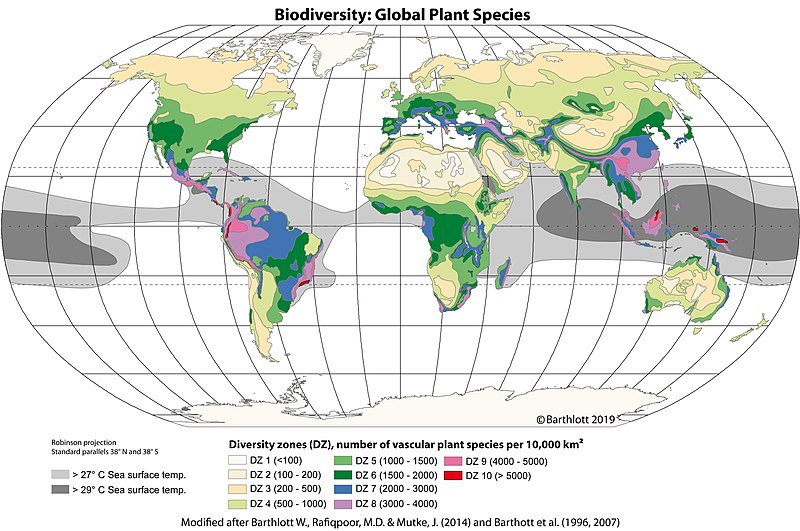
Species richness is related to latitude: the greatest species richness occurs near the equator and the lowest richness occurs near the poles (Figure \(\PageIndex{4}\)). Several hypothesis might explain this dyanamic, but the exact reasons for this pattern are still not clearly understood. One hypothesis is that tropical forests have consistently existed at the same location for a long period of time, allowing more time for speciation to occur. Another hypothesis is that speciation rate is simply higher in the tropics than other regions. The tropics also has a long growing season and a wide variety of ecological niches (different roles that species can occupy), partly due to the different vertical layers in a tropical forest (Video \(\PageIndex{1}\)). Other factors besides latitude influence species richness as well. For example, ecologists studying islands found that biodiversity varies with island size and distance from the mainland.
Video \(\PageIndex{1}\): This video discusses possible explanations for why species richness is high at the equator.
In 1988, British environmentalist Norman Myers developed a conservation concept to identify geographical areas rich in species and at significant risk for species loss: biodiversity hotspots. The original criteria for a hotspot included the presence of 1500 or more endemic plant species and 70 percent of the area disturbed by human activity. Endemic species are found in only one location. For example, giant lobelia (Lobelia rhynchopetalum, Figure \(\PageIndex{5}\)) is only found in the alpine habitats in Ethiopia. Endemic species with highly restricted distributions are particularly vulnerable to extinction. If a population of a widespread species declines in one region, individuals from another region may be able to recolonize the first location, but this is not possible for endemic species. Endemic species are particularly common in isolated regions, such as mountaintops or islands. Identifying biodiversity hotspots aids with conservation efforts, a kind of conservation triage. By protecting hotspots, governments are able to protect a larger number of species. There are now 34 biodiversity hotspots (Figure \(\PageIndex{6}\)) containing large numbers of endemic species, which include half of Earth’s endemic plants.
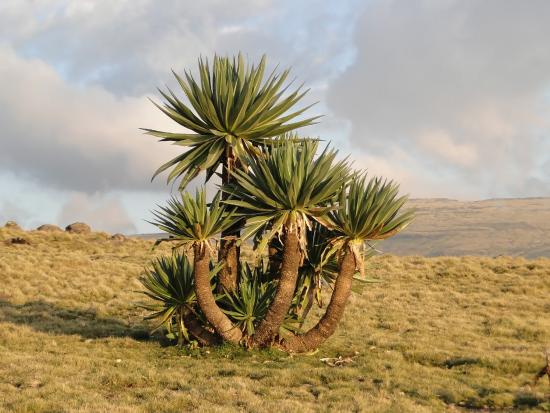
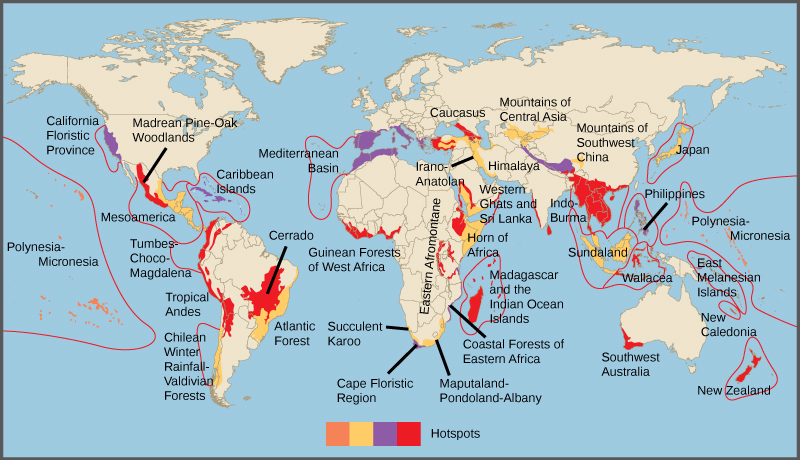
Regarding species evenness, foundation species often have the highest relative abundance of species. Two locations with the same richness do not necessarily have the same species evenness. For example, both communities in Figure \(\PageIndex{7}\) have three different trees species and thus a species richness of three. However, there is a dominant species (represented by six individuals) in community #1. In community #2, there are three of individuals of each species. Therefore, community #2 has a greater species evenness and greater species diversity overall.
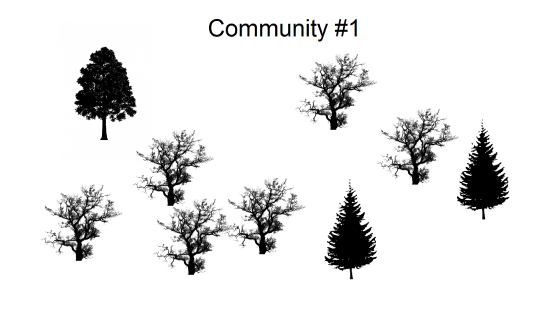

Healthy ecosystems contain a diversity of species, and each species plays a role in ecosystem function; therefore, species diversity as well as ecosystem diversity are essential to maintaining ecosystem services. For example, many medications are derived from natural chemicals made by a diverse group of organisms. For example, many plants produce compounds meant to protect the plant from insects and other animals that eat them. Some of these compounds also work as human medicines. Examples of significant medicines derived from plant compounds include aspirin, codeine, digoxin, atropine, and vincristine (Figure \(\PageIndex{8}\)). It is estimated that, at one time, 25 percent of modern drugs contained at least one plant extract. That number has probably decreased to about 10 percent as natural plant ingredients are replaced by synthetic versions of the plant compounds. Antibiotics, which are responsible for extraordinary improvements in health and lifespans in developed countries, are compounds largely derived from fungi and bacteria. It is estimated that about 35 percent of new drugs brought to market between 1981 and 2002 were from natural compounds.
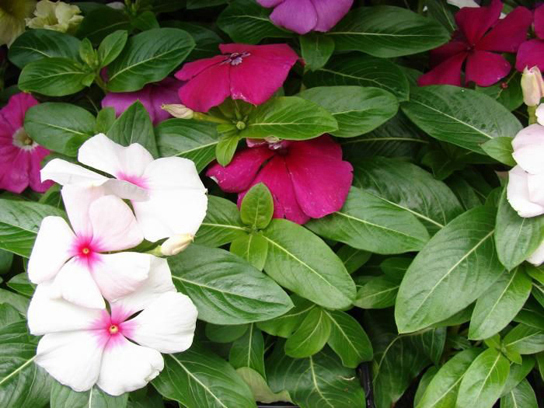
Genetic Diversity
Genetic diversity is a measure of the variability among individuals within a single species. Genetic diversity is represented by the variety of alleles present within a population. Genetic diversity provides the raw material for evolutionary adaptation. Loss of genetic diversity makes a species less able to reproduce successfully and less adaptable to a changing environment or to a new disease. Small populations of species are especially susceptible to loss of genetic diversity. When a species loses too many individuals, it becomes genetically uniform. Some of the causes for the loss in genetic diversity include: inbreeding among closely related individuals and genetic drift, the process by which the genetic composition of a population fluctuates randomly over time. Genetic drift can lead to the loss of alleles from a population, even if those alleles are adaptive. For more on genetic drift, see Openstax 2e 19.1.
Genetic diversity is important to agriculture. Since the beginning of human agriculture more than 10,000 years ago, human groups have been breeding and selecting crop varieties. This crop diversity matched the cultural diversity of highly subdivided populations of humans. For example, potatoes were domesticated beginning around 7,000 years ago in the central Andes of Peru and Bolivia. The people in this region traditionally lived in relatively isolated settlements separated by mountains. The potatoes grown in that region belong to seven species and the number of varieties likely is in the thousands. Each variety has been bred to thrive at particular elevations and soil and climate conditions. The diversity is driven by the diverse demands of the dramatic elevation changes, the limited movement of people, and the demands created by crop rotation for different varieties that will do well in different fields.
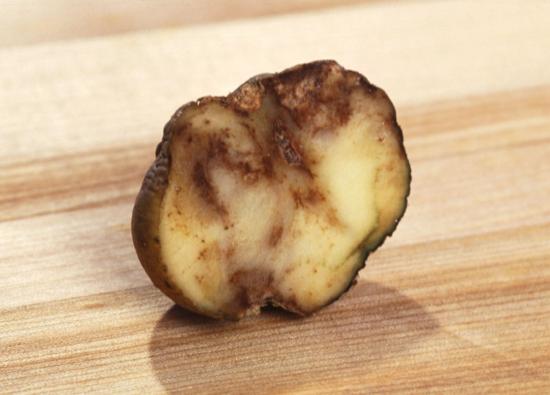
The potato demonstrates a well-known example of the risks of low crop diversity: during the tragic Irish potato famine (1845–1852 AD), the single potato variety grown in Ireland became susceptible to a potato blight—wiping out the crop (Figure \(\PageIndex{9}\)). The loss of the crop led to famine, death, and mass emigration. Resistance to disease is a chief benefit to maintaining crop biodiversity and lack of diversity in contemporary crop species carries similar risks. Seed companies, which are the source of most crop varieties in developed countries, must continually breed new varieties to keep up with evolving pest organisms. These same seed companies, however, have participated in the decline of the number of varieties available as they focus on selling fewer varieties in more areas of the world replacing traditional local varieties.
The ability to create new crop varieties relies on the diversity of varieties available and the availability of wild forms related to the crop plant. These wild forms are often the source of new gene variants that can be bred with existing varieties to create varieties with new attributes. Loss of wild species related to a crop will mean the loss of potential in crop improvement. Maintaining the genetic diversity of wild species related to domesticated species ensures our continued supply of food.
Since the 1920s, government agriculture departments have maintained seed banks of crop varieties as a way to maintain crop diversity. This system has flaws because over time seed varieties are lost through accidents and there is no way to replace them. In 2008, the Svalbard Global seed Vault, located on Spitsbergen island, Norway (Figure \(\PageIndex{10}\)), began storing seeds from around the world as a backup system to the regional seed banks. If a regional seed bank stores varieties in Svalbard, losses can be replaced from Svalbard should something happen to the regional seeds. The Svalbard seed vault is deep into the rock of the Arctic island. Conditions within the vault are maintained at ideal temperature and humidity for seed survival, but the deep underground location of the vault in the arctic means that failure of the vault’s systems will not compromise the climatic conditions inside the vault.
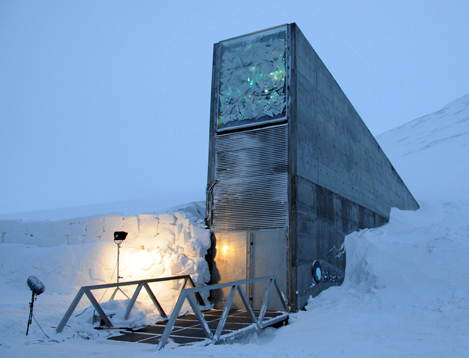
References
Costanza, R., d'Arge, R., de Groot, R. et al. The value of the world's ecosystem services and natural capital. Nature 387, 253–260 (1997). DOI
Kremen, C., Williams, N. M., and Thorp, R. W. Crop pollination from native bees at risk from agricultural intensification. PNAS 99, 6812-16816 (2002). DOI
Attributions
Curated and authored by Melissa Ha using the following sources:
- 4.4 Community Ecology, 5 Conservation & Biodiversity, and 5.3 Importance of Biodiversity from Environmental Biology by Matthew R. Fisher (CC-BY)
- 47.1 The Biodiversity Crisis and 47.4 Preserving Biodiversity from Biology 2e by OpenStax (licensed CC-BY). Access for free at openstax.org.
- 6.3 Biodiversity, Species Loss, and Ecosystem Function from Sustainability: A Comprehensive Foundation by Tom Theis and Jonathan Tomkin, Editors (CC-BY). Download for free at CNX.
- 12 Biological from AP Environmental Science by University of California College Prep, University of California (CC-BY). Download for free at CNX.


